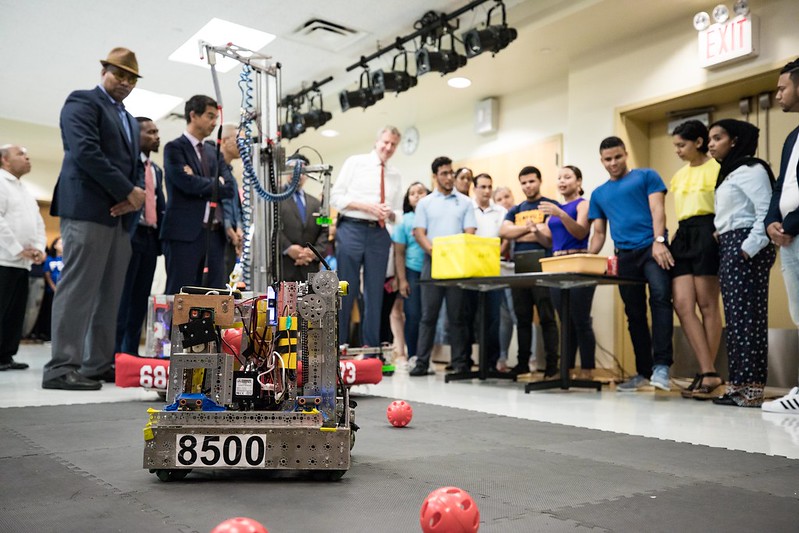
Robotics and tech ed (photo: Benjamin Kanter/Mayor's Office)
With more than half-a-million New Yorkers out of work amid a painful economic downturn, the continued growth of tech positions stands out as a beacon of economic recovery. Connecting more residents with these jobs presents an important opportunity for the next mayor to get New Yorkers working again.
Despite months of grim economic news, tech firms have continued to double down on New York City. Over the past year, companies including Google, Facebook, Apple, Amazon, and Netflix have signed new leases, ramped up hiring, and invested millions of dollars in the city.
This deepening commitment is reflected in the latest hiring data: Since the pandemic hit, new research reveals that New York City employers have posted more openings for tech roles than any other job category—over 67,000 in all. In total, nearly one in five (18%) jobs posted from April to November 2020 was for a tech position. That’s greater than the demand for healthcare jobs, more than double that of finance positions, and almost five times larger than hospitality or education. And the growth of tech roles isn’t limited to the tech sector, but threaded across nearly every part of the economy, from health care and education to finance, media, transportation, and manufacturing.
But far too few of the most economically vulnerable New Yorkers and their families—from young children to out-of-work adults—have access to high quality computing education or in-depth training for tech careers. As a result, many of these good jobs remain out of reach for New Yorkers with the most to gain.
To rebuild a more equitable city in the months and years ahead, this will have to change.
The city’s next mayor, elected this year to take office January 1, should launch a bold, long-term plan to expand and improve the tech skills-building ecosystem, backed up by significant new public investment. An expansion of both career training and K-12 computing education can help dislocated workers get on the path to in-demand occupations and ensure that future generations of New Yorkers build computational thinking skills as part of a sound basic education.
Policymakers face an enormous need—and an important opportunity—to make those crucial investments now. After a year of virtual schooling, the need for investment to close the city’s digital divide has never been clearer. The Department of Education (DOE) deserves credit for distributing more than 320,000 devices to students and improving WiFi connectivity, but the problem extends far beyond hardware. Too many schools lack quality computing education at all grade levels, and too many teachers and administrators were ill-prepared to manage the transition to virtual learning. The opportunity divide is growing as a result.
That’s why the next mayor should commit to a new level of investment in K-12 computing education: preparing New Yorkers to pursue STEM degrees at CUNY and to succeed in training programs for tech careers. The newly-adopted 2021-2022 state budget presents an important opportunity to do just that by allocating more than a billion dollars in long-sought additional education funding to New York City. City leaders should use this funding to ensure that every student can experience effective, age-appropriate computing education.
It starts with building on—and going beyond—the success of the city’s Computer Science for All (CS4All) initiative, which has embedded computer science education in more than 825 public schools since 2015. The next mayor should champion the program’s expansion to reach every student by 2025 and ensure that DOE has the institutional support and accountability to keep on pace.
Next, city leaders should focus on expanding computing education in grades K-5, where current offerings are limited. Early exposure to foundational computing education can help close achievement gaps for low-income students and shape early attitudes toward technology careers. The next mayor should lay out a vision for universal computing education.
To accomplish this, the city should also invest in professional development and pre-service training in computing education, building on a promising pilot program at CUNY. That way, every teacher can gain the tools needed to integrate computational thinking into their classrooms.
The challenges fueled by the pandemic have also exacerbated preexisting holes in the city’s tech skills-building ecosystem for adults. Fortunately, New York City is home to a number of high-quality tech training programs that consistently lead to good jobs for New Yorkers from underrepresented communities. But most of these programs serve from a few dozen to a few hundred people annually, when New York needs to be reaching thousands. The next mayor needs to scale up these effective tech training programs to reach their full potential.
At the same time, far too many New Yorkers from low-income communities lack the literacy, numeracy, and digital skills needed to qualify for the best tech training programs . The next mayor needs to build a new infrastructure of bridge programs, providing onramps to tech career training for those without a high school diploma or with limited English proficiency.
In addition to skills needs, cost barriers prevent New Yorkers from accessing workforce development programs—even ones that are tuition-free. The city should step up its support for the many non-tuition roadblocks to career advancement, from lack of childcare or at-home WiFi to the cost of transportation, and incentivize providers to collaborate on wraparound services.
A deep and diverse talent pool will help ensure that tech-powered industries can stay here and grow, while producing good jobs for New Yorkers. To tap this powerful opportunity, the next mayor should make a long-term investment in K-12 computing education and tech career training, equipping every New Yorker with the skills, tools, and opportunities they need to thrive in a digital world.
***
Eli Dvorkin is editorial and policy director of the Center for an Urban Future. Amber Oliver is managing director of Robin Hood Learning + Technology Fund. On Twitter @nycfuture & @RobinHoodNYC.
***
Have an op-ed idea or submission for Gotham Gazette? Email This email address is being protected from spambots. You need JavaScript enabled to view it.




